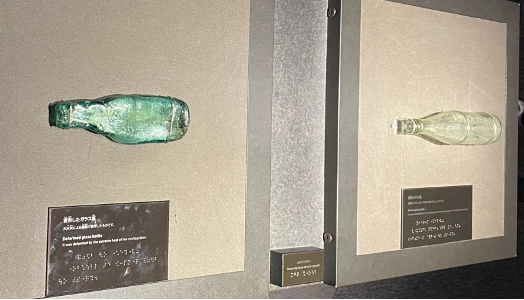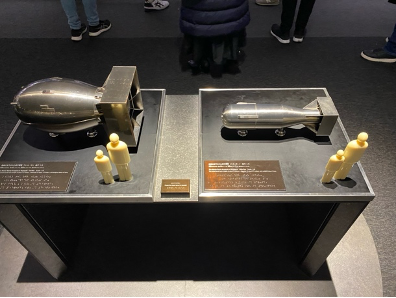Letters Home, Pt. 2
- Izabel "Iza" Mah y Busch
- Mar 1, 2024
- 5 min read
Updated: Mar 11, 2024
Dear Family and Friends,
Today was spent at Hiroshima Peace Memorial Museum. We were given earpieces with devices to give additional information during certain parts of the museum. The first part of the museum had pictures on the walls of before the A-bomb then after and then there was a model of what the city looked like with a projected animation demonstrating the catastrophe of the A-bomb. Then I followed the signs guiding all visitors through the museum, which was to my surprise incredibly English friendly. All the signs that had Japanese writing had English just under it and not in a smaller font. The hallway was painting black and right at the end of the hallway was a single photo.
Visitors stopped patiently to look at the photo. To bear witness to the girl in the photo so that we can keep this moment in our memory. I don’t know what she was feeling in the photo, having survived something so inhumane and other worldly, but there is a quality of expression in the photo that does not look particularly hateful, or fearful. I have no doubt in my mind that there was fear, but after having survived and seen what others may have gone through on top of the adrenaline, I wonder if she’s numb. I wonder if she saw what she looked like, at this point had she known what she survived. So many questions, such a candid photo, I feel like I could just reach into it.
The museum was organized is such a way to tell a story, a story from the ground up, from the people. Today, there were a lot of people, lines for every item throughout the museum, especially at the beginning. So many people made the room hot, with the black walls, the room was stuffy.
In the beginning portion of the museum, there were pieces of metal that had instantly fused together demonstrating the sheer amount of heat, but also how powerful the A-bomb instance must have been that metal fused with other materials and became unrecognizable. Then there were pieces of clothes that were taken from survivors and the clothes were destroyed and burned. Many of the clothes were unrecognizable. Just rags and pieces with stains all throughout. After seeing what had happened to the metal, at this point in the museum I couldn’t even imagine what had happened to the people who these clothes used to cling to. All these items precluded the pictures detailing the horrors that real people had to live through.
After this part of the museum came pictures of the bodies and the extent of damage the A-bomb did to human life. It was really hard to look, and I cannot describe what I saw without feeling aspects of the experience would be completely lost. Everyone should bear witness to the violence done to bodies, every American has the responsibility to bear witness to what our government does not just for ourselves and to know, or to keep our government accountable, but for the rest of the world. In that the act of bearing witness, repeatedly, beyond our borders will globalize us culturally to be more aware. When we vote, our vote impacts the world, but we think and are told our vote is for the betterment of America. There is a reason the world is aware of American politics, and I think there is an intentionality to keep our American populations internationally ignorant.
On top of witnessing, the sheer unnatural violence of the bomb through the clothes and statements from families of victims, the drawn renditions of what the bomb did were really powerful. So many of the drawings were by children and civilians. The reds and greens were intense against the off-white, and the lighting seemed to really highlight the colors on the page. It was really hard to go through the museum. It was hard to see pillowcases with stains on them knowing a head was once there. That they were in incredible pain, that their family watched not knowing what to do to take the pain away, that in the moment no one really knew what had just happened and that for many of them, the violence of the A-bomb had just begun.
After the portion detailing the violence done to the people, there was a portion that detailed the science behind the bomb along with the sizing. Along with demos that showed what happens to glass when put in contact with nuclear power.
Why would such weaponry ever be necessary. I wonder why scientists thought this form of scientific discovery would be okay to bring into the world, and such lack of foresight. Scientists and the STEM community, by virtue of existing in this world have a responsibility to this world and the people who inhabit it. I feel as though the scientific community thinks they can turn a blind eye or focus on discovery for the sake of discovery or for the sake of their own pursuit of career. Most scientific discoveries within the US funnel directly to the US government and the US military. Science pretends its apolitical, but the absence of these conversations is a politic in and of itself.
It was depressing to see that at the end of the whole museum the US did not touch this treaty.
The US has made war profitable, in fact, most of our taxpayer money goes to war, militarization, and policing. I would argue that because we are such a militarized state, our own police force cracks down on its own citizens as if they were at war. We are a war state, as Noam Chomsky states, “The US is a leading terrorist state.” The US in fact, has a long history—in its own short history—of funding and supporting terrorists and military coups all over the world. My hope is that Americans continue to bear witness to the ugly histories we fund, not just for ourselves, but for the rest of the world and that we understand that our vote is not just a vote for our own bodies but for bodies abroad. The airstrikes that the US conducts on Arab states, they kill 5-15 civilians every time, these are numbers we will never see, just as the catastrophe of Hiroshima and Nagasaki gets a paragraph in American history books. These are not numbers, these are people, family lineages that will forever have absences throughout them and that will continue to haunt. The fact that a ceasefire in Gaza is controversial is disgusting, the fact that the preservation of life is met with violence from the other side is despicable.
This museum was so powerful as it calls for an end, not just to honor those who suffered the A-bomb immensely but for the betterment of the whole world. Everyone would benefit from an end to war and nuclear weaponry. I also urge my peers and young people, to act now, do not wait until after a catastrophe has ended to speak up, speak up during even though its uncomfortable, fight against authority now so that together we can change the status quo so that someday, we will have a presidential candidate that is truly for the preservation of life.
I want to end this blog coming back to the girl we started with. She survived the A-bomb and lived a full life but succumbed to the aftereffects of the A-bomb. Nuclear weaponry stays in the land and body beyond the instance. There is absolutely no reason for any person to ever be deserving of such pain and suffering. What are we afraid of that we think we need such devastating weaponry. Who are we fighting. Or have we so dehumanized people beyond our borders that we think nuclear weaponry is necessary. I hope reader, you keep her in your heart and I hope her memory urges you to live a life that preserves and protects life above all things.
-Iza Mah y Busch











Comments